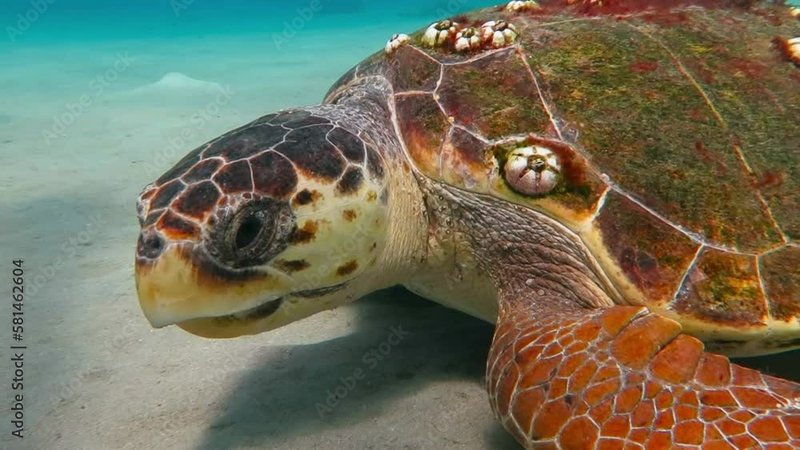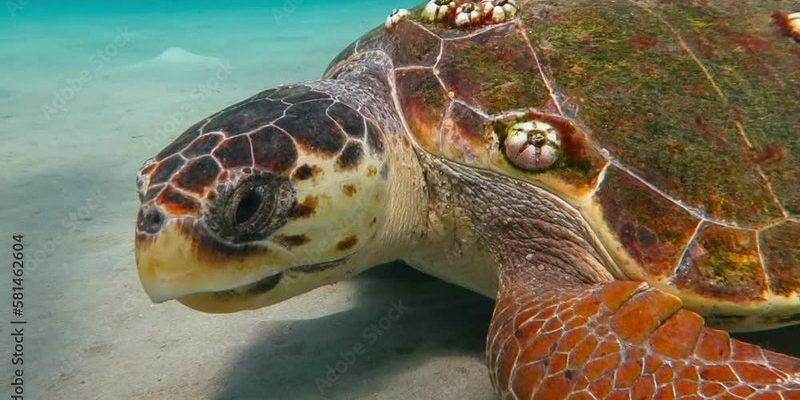
Picture exploring a vibrant underwater city filled with colorful fish, coral reefs, and seaweed. The loggerhead turtle navigates this environment with ease, thanks to its incredible adaptations. From a tough shell to specialized flippers, each feature plays a crucial role in helping it find food, evade predators, and even migrate long distances. Let’s dive into these adaptations to understand how the loggerhead turtle not only survives but thrives in its watery habitat.
Strong Shells: Nature’s Armor
One of the most noticeable features of the loggerhead turtle is its strong shell, known as the carapace. This hard exterior serves multiple purposes. First and foremost, it’s a powerful defense mechanism against predators like sharks and larger fish. Just think about how a snail retreats into its shell for safety; loggerheads do the same. Instead of hiding, their shell acts as a shield, allowing them to feel more secure in their underwater world.
The carapace is also designed to reduce drag while swimming. Its streamlined shape helps the loggerhead glide through water with minimal effort, conserving energy during long migrations. This is particularly crucial, as these turtles can travel thousands of miles between feeding and nesting sites. So, when you see a loggerhead swimming gracefully, remember that its shell is more than just a protective layer; it’s a masterpiece of evolution.
Powerful Flippers for Efficient Swimming
Now let’s talk about those powerful flippers! Loggerhead turtles have large, paddle-like flippers that are perfect for navigating through the ocean. These flippers allow them to swim efficiently, propelling them forward in search of food or during long-distance migrations. Just like a bird uses its wings to ride the currents in the sky, loggerheads use their flippers to harness ocean currents, conserving energy as they swim.
Interestingly, these flippers aren’t just for swimming; they also help loggerheads with other important tasks. For instance, female loggerheads use their flippers to dig nests in sandy beaches during nesting season. Isn’t it amazing how these same flippers can serve different purposes? The versatility of their flippers plays a big part in their success as a species.
Coloration and Camouflage
Loggerhead turtles also have a keen sense of how to blend in with their surroundings. Their brown and tan shells mimic the colors of the ocean floor and the sandy beaches where they nest. This natural camouflage helps them avoid predators and catch prey. Think about how you might wear earthy tones to blend in at a campfire; loggerheads do something similar in the ocean.
Being less visible is a survival tactic that helps these turtles hunt for food, which primarily includes jellyfish, crustaceans, and seaweed. When they’re hovering near the seafloor or in the midst of a jellyfish bloom, their coloration helps them stay hidden. This way, they can sneak up on their meals without alarming them or attracting unwanted attention from predators.
Efficient Digestion for Nutrient Absorption
Loggerhead turtles are remarkable for more than just their physical traits; their digestive systems are finely tuned to extract maximum nutrients from their varied diet. These turtles have strong beaks that can crush hard-shelled prey, like conchs and crabs. It’s like having a built-in tool to help them enjoy a hearty meal!
Once they consume food, their system works efficiently to break it down. Loggerheads have a long intestine that aids in digesting and absorbing nutrients. In a world where food can be scarce, these adaptations ensure that the turtles get the most out of every meal. Plus, they can go long periods without eating, making them well-suited for their sometimes unpredictable environment.
Advanced Navigational Skills
You might be wondering how loggerhead turtles find their way across vast oceans. Their incredible navigational skills are another key adaptation that helps them thrive. Loggerheads are believed to use the Earth’s magnetic fields to navigate, much like a built-in GPS. This ability is essential, especially during migration, when they travel between feeding sites and nesting beaches.
Researchers have found that loggerhead turtles can detect magnetic fields and even use the position of the sun and stars to guide them. It’s as if they have a map permanently ingrained in their instincts! This remarkable navigation capability ensures they can return to the same nesting sites year after year, showcasing a natural instinct that’s been passed down for generations.
Respiratory Adaptations for Underwater Life
Diving deeper into the underwater world, let’s explore how loggerhead turtles breathe. Although they’re aquatic, loggerheads are reptiles, which means they need to breathe air. But here’s the cool part: they can hold their breath for long periods—sometimes up to several hours—while diving. This ability allows them to explore deeper waters without needing to surface constantly.
Their lungs are adapted to maximize oxygen intake and minimize energy expenditure. Whenever they need to, they can pop to the surface for a quick breath and then dive back down to hunt or explore the ocean depths. It’s all about balance. This adaptation is essential for a creature that spends so much of its life in the water, allowing it to thrive in various ocean environments.
Loggerhead turtles are a testament to the wonders of nature and evolution. Their incredible adaptations—from strong shells and powerful flippers to their keen navigation and respiration techniques—allow them to survive and flourish in a complex underwater world. They’re not just surviving; they’re thriving, showcasing the beauty of life beneath the waves.
As we continue to learn about these remarkable creatures, it’s essential to appreciate the delicate ecosystems they inhabit. When we protect their habitats, we preserve the adaptations that make loggerhead turtles the extraordinary survivors they are. So next time you think about the ocean, take a moment to appreciate the loggerhead turtle and all the adaptations that help it thrive underwater. It’s a powerful reminder of the resilience of life in our beautiful, blue planet.

